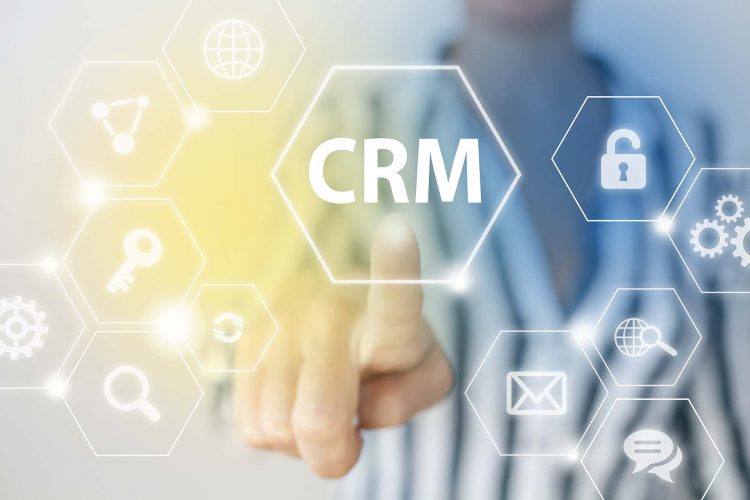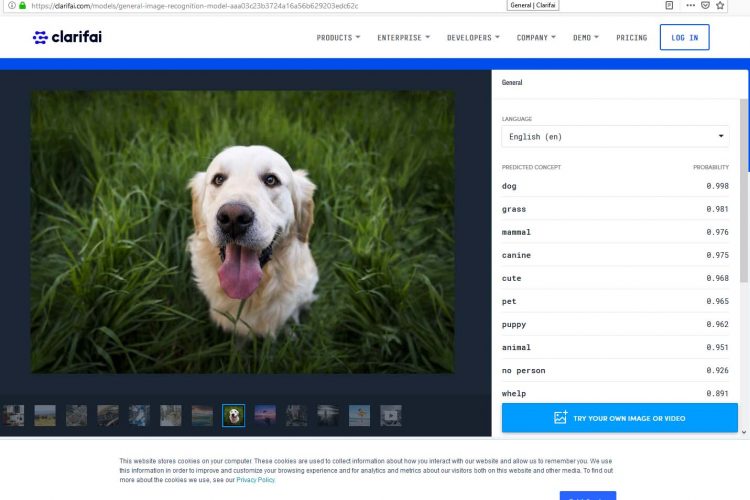Top Posts

What is that often quoted line from Hamlet? "To be or not to be... That is the question!" ...
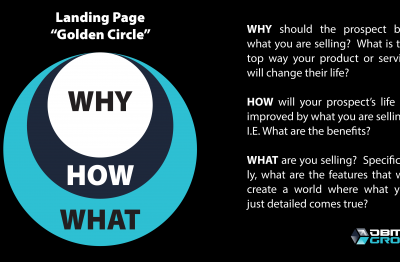
Use the "Golden Circle" to ensure you landing pages have everything your prospect need to ...

From time to time we have clients that ask us:
"Can't we just email to this list we ...
Google just released a new algorithm update called “BERT” – which stands for “Bidirectional Encoder Representations from Transformers.”
In this update Google is using “transformers” or words before/after another word that will change the overall intent of the phrase. Or as Google put it:
“This breakthrough was the result of Google research on transformers: models that process words in relation to all the other words in a sentence, rather than one-by-one in order. BERT models can therefore consider the full context of a word by looking at the words that come before and after it—particularly useful for understanding the intent behind search queries.” – Google Blog
Here are a couple examples that Google provided with their explanation.
Example 1:
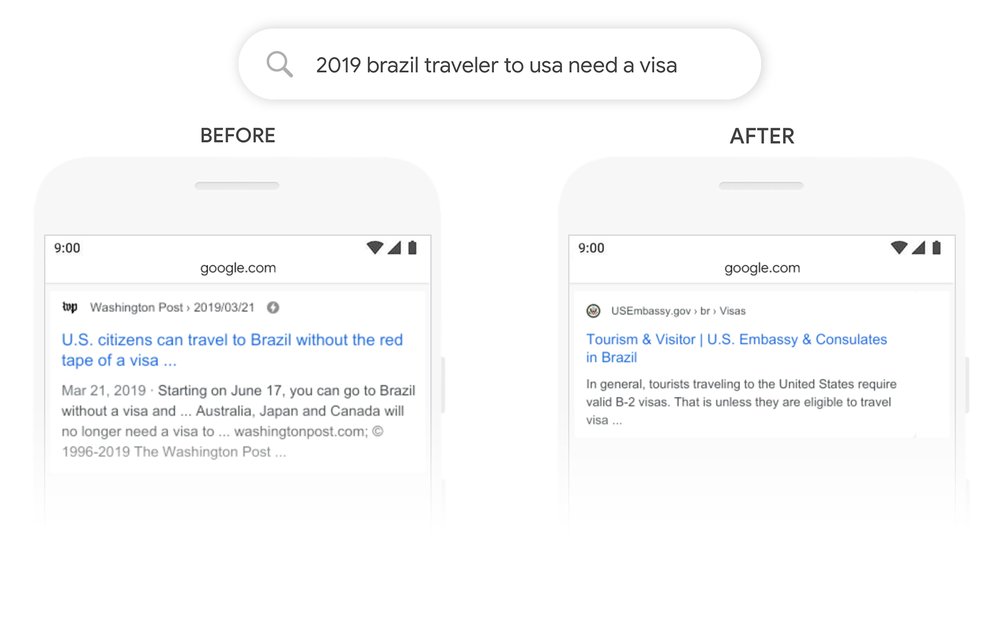
Here’s a search for “2019 brazil traveler to usa need a visa.” The word “to” and its relationship to the other words in the query are particularly important to understanding the meaning. It’s about a Brazilian traveling to the U.S., and not the other way around. Previously, our algorithms wouldn’t understand the importance of this connection, and we returned results about U.S. citizens traveling to Brazil. With BERT, Search is able to grasp this nuance and know that the very common word “to” actually matters a lot here, and we can provide a much more relevant result for this query.
Example 2:
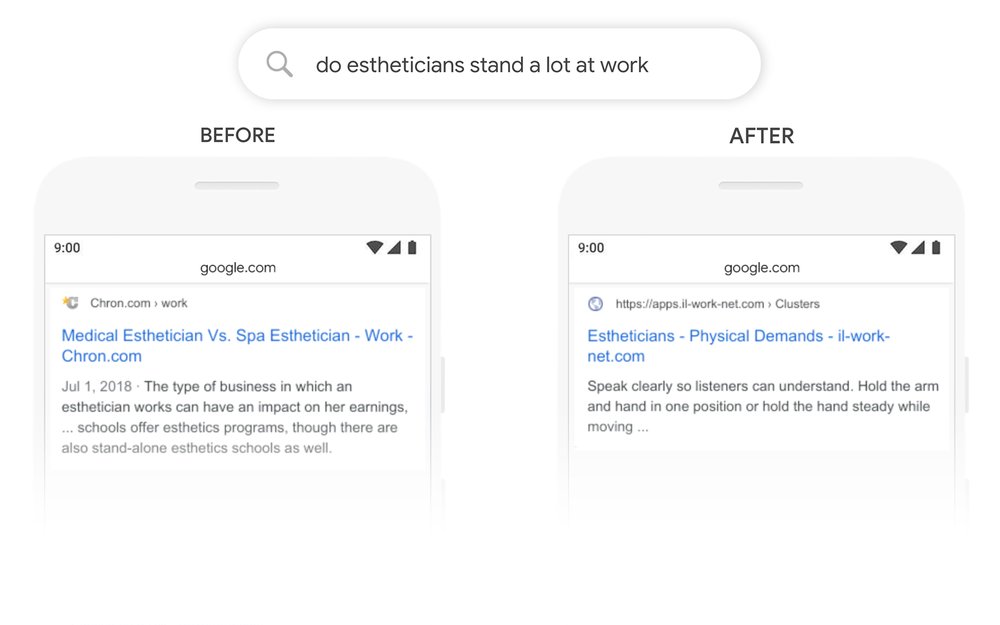
Let’s look at another query: “do estheticians stand a lot at work.” Previously, our systems were taking an approach of matching keywords, matching the term “stand-alone” in the result with the word “stand” in the query. But that isn’t the right use of the word “stand” in context. Our BERT models, on the other hand, understand that “stand” is related to the concept of the physical demands of a job, and displays a more useful response.
What does this mean?
Now I know what you are thinking… What does this mean? How will this change my ranking?
First, you should always be monitoring your ranking to see if there is any change.
Second, this change is going to affect mostly “sentence” or “long-tail” type searches. This should make you happy, as this change should help potential clients who are looking to BUY your services find you.
In a nut shell, if you create long form content that conveys the “intent” that your targeted user should have when visiting your site – you should come out on top.
Please contact us for more info on how it increase your SEO rankings.
As a business owners, you might find yourselves wearing a dozen different hats during any given day. You’ve got sales calls or customer service or employee management or marketing or brand management or product development or inventory control or any number of other things that need to be taken care of.
So, among those things, what is your most important asset? You could certainly make a case for your Brand or your products or your employees or your customers. Depending on your perspective at any given moment, each of those things could be categorized as your “MOST IMPORTANT” asset.
But I want to challenge you to think a bit more abstractly about this. While all of the things listed above are critical to your business, it’s important to consider another thing that business owners value immensely…
TIME
Your time is likely your most valuable asset. You have a finite amount of it. You can’t get more than 24 hours out of any day. But you CAN use your time more efficiently and effectively. And that’s one of the many ways that DBMGrow helps businesses and business owners.
Over the past decade, DBM Grow has worked with companies to automate the process of doing business. This has manifested itself in a number of ways. And, as a business owner who values time, I’d encourage you to reflect on these.
- Automating interactions via social media
- Creating templates and standards for employees, staff or colleagues to follow
- Standardizing processes and procedures for HOW you conduct business
- Automating lead follow-up processes
- Connecting multiple pieces of information and data to better understand your business and it’s bottom line
These are just a few examples. But hopefully they get you to look at what and how you are doing things on a daily basis. More importantly, where can you save time, effort and energy in automating or standardizing a process? What are some things that you MUST do in your business, but hate doing? What are things that need to be done, but they feel like a waste of YOUR time? What are the things that you avoid doing until the last minute? What are the things that frustrate you because of their monotonous, repetitive nature?
Those are great questions to ask yourself as you look at protecting your most valuable asset…your TIME.
One of my favorite business books is “The 4 Disciplines of Execution” or “4DX” for short. It lays out a specific technique for how you can achieve your business goals. If you haven’t read the book (or listened on Audible), I suggest you start today!
The 4DX steps are:
- Focus on the Widly Important
- Act on the Lead Measures
- Keep a Compelling Scoreboard
- Create a Cadence of Accountability
My goal isn’t to write a summary of the 4DX steps; I just want to focus in on steps #2 and #3.
Step 2 details how you should know your key performance indicators (KPI), and break them into two groups.
- Lag Measures – KPI that you can only measure after the sale
- Lead Measures – KPI that you can measure before the sale
Step 3 details how you should display your specific KPI (Lead and Lag) on a scoreboard for your entire organization.
But… How can you actually do that?
This is where most businesses give up. They either don’t know how to track the data, or they have lots of data but don’t know how to effectively “wrangle” it into a cohesive dashboard. DBM Grow can help you:
- Decide what data to track
- Build a data model and a platform to facilitate tracking
- Manage the roll out of KPI dashboard using analytic tools
Here are two affordable tools that we use to create KPI dashboards for our clients.
Klipfolio
In Klipfolio you make data widgets called “klips” and put klips together to form dashboards. Klipfolio connects to all major data sources, and is affordable ($70 – $570 / month). It does have a learning curve, but it doesn’t charge for different integrations. More about Klipfolio
Clicdata
Clicdata differs from Klipfolio in that you make each dashboard independent of the other dashboards. You don’t create widgets and place them, you build the dashboard as one complete unit. But, Clicdata is much more of a “drag and drop” kind of platform. Its learning curve is much smaller than Klipfolio, which usually means the time to create a couple dashboards is much shorter. It is similarly priced ($29 – $499 / month), but if you want to use a MySQL data connector you will need one of the more expensive packages. More about Clicdata
I Want One! Now What?
If you have a tech savvy person on your team, you can pull your data together and build your KPI dashboards yourself. Or, take advantage of our nerd team and contact us for a free consultation on what the best plan is for your situation.
Security is a currently huge hot button issue with all of our clients. It used to be that if you weren’t “selling” anything on your website you didn’t really have to worry about website security. But those days are long gone!
As recent news reports have shown us, no system is 100% secure. We have seen Fortune 500 companies that spend millions on security breached. So what can a small business owner do to protect themselves?
1. Ensure your site has an secure socket layer (SSL) certificate installed
 I’m sure you have see the little lock icon next to the web address in your browser, but do you know what it means? The lock icon means that all the data sent to and from your computer (laptop, smartphone, tablet, whatever…) is encrypted. Therefore, if a “hacker” is able to look at your data stream, it would be gibberish.
I’m sure you have see the little lock icon next to the web address in your browser, but do you know what it means? The lock icon means that all the data sent to and from your computer (laptop, smartphone, tablet, whatever…) is encrypted. Therefore, if a “hacker” is able to look at your data stream, it would be gibberish.
This is not only important to protect your user’s data, as it is sent to your website, but most websites have an “admin” or “management” portal that is accessed using a username and password. Having an SSL protected site will protect others from gaining access to your website.
The cost of an SSL certificate can vary from $0 – $800 per year. Most hosting plans will provide you a basic SSL certificate at no cost.
2. Use a web application firewall (WAF)
How many movies have you seen where somebody yells out: “they’ve breached the firewall!” Do you really know what a firewall is? Basically, a firewall is a piece of code that looks at network traffic and stops “bad” traffic and allows “good” traffic. A web application firewall (WAF) is specific kind of firewall that looks at visitors to your website and stops visitors from doing bad things. They may be accessing your website through a legitimate means, but what they are doing on your site isn’t.
The cost of a WAF is around $20 per month, but normally WAF providers will also include other services (like a CDN) for no additional charge.
3. Back-up your site daily
Knowing your website is backed up is like a “warm blanket” that removes stress! If your site is compromised, you can restore from your last back and be back up and running in no time. Let’s be honest, if your site is down, the only question you want answered is – “when will it be back up again?!?!”
The cost of daily back-ups vary from $0 – $5 / month. I would first check with your hosting company on how often your site is backed up. How many back-ups are kept? (If you don’t notice the error for a couple days and you only keep one day of back-up… You are out of luck!) Cost and timeline to restore a back-up. If your host doesn’t have a clear and quick method for you to see your back-ups and restore them; I would recommend getting an off-site back-up service. An extra $5 / month is well worth the peace of mind!
4. Update your content management system (CMS) monthly
 Almost every modern website is built using a content management system (CMS). The most common are WordPress and Joomla, but you may know it just as the “admin” or “management” portal. If your website has login where you can edit the content of your website, then you have a CMS.
Almost every modern website is built using a content management system (CMS). The most common are WordPress and Joomla, but you may know it just as the “admin” or “management” portal. If your website has login where you can edit the content of your website, then you have a CMS.
A majority of security breaches occur because your CMS was compromised. Either through a bug in the CMS code or through the “hacker” gaining knowledge of your login credentials. In the SSL section I covered how your CMS credentials could be compromised, so we won’t review that issue. The second potential problem is a security hole (or “bug”) in the CMS code. If you are using a current CMS then the code will get updated monthly, and you should update your server’s version of the CMS when new updates are released.
There are paid tools that can help you track and update your CMS, but generally you simply have to login and click “update.” Of course, do a back-up before you do any updates!
5. Monitor your site daily
This seems like a “no brainer” but check on your website daily. A simple and easy way to avoid your clients seeing a compromised website is to check it daily and revert to back-up quickly. This will also ensure you site never lands on a “blacklist” – because once your site is on a blacklist it can take weeks or months to get it removed.
There are 3rd party tools that will “ping” or check your site for you, but you can easily make it part of your daily or weekly processes.
Conclusion
There is no guarantee that your site won’t get “hacked” but there are simple steps you can take to avoid a compromised site or to be back up and running quickly after a compromise.
If you are a client of ours and have our “customer care” plan, these are all things we automatically do for you.
When talking with our clients, one topic that comes up regularly is: “I wish I could get an app for that!”
Now they aren’t talking about an app to walk their dog or take out the trash. For years business owners and senior managers have lamented the fact that only enterprise organizations with VERY deep pockets have been able to afford an app specifically for their business.
But, that time is gone!
And nobody knows!
Companies have been told that simple apps cost $100k+ to develop and release, and so they quit asking the question…
“Can we build and app for that?”
In 2015 Facebook released a programming framework called “React Native.” React Native is used to develop applications for Android, iOS and UWP by enabling developers to use React (JavaScript library) along with native platform capabilities.
This has brought feasibility of a small business to have an app of their own.
So, if you have ever thought… “I wish we had an app…” It may no longer be wishful thinking!
Prepare to be amazed and inspired by the newest craze in marketing…Mirror Marketing. Truth be told, there are two mirrors within this wild new idea that should be explained and explored.
Actually, Mirror Marketing isn’t new at all. It’s been around since the beginning of time. I’ve just used a little bit of alliteration to slap a fancy name on it. Mirror Marketing is probably best explained with the common phrase “don’t reinvent the wheel”. The idea is simple really. Take a look around at the SUCCESSFUL people providing the same services or products as you and “mirror” what they’re doing.
Undoubtedly, there may be a learning curve to the process, but copying success isn’t a bad idea. A number of our clients exist in professional industry groups that share ideas and brainstorm about what is working for them and what has failed to meet expectations. If others in your industry are having success, take a closer look at them and “mirror” what they are doing. Are they waking up at 5am? Are them running radio ads during rush hour? Are they handing out flyers at carnivals?
The second mirror in this amazing marketing idea is the mirror that you use to shave or curl your hair or brush your teeth every morning. Before you ever decide to copy the success of someone else, you should take a good hard look in that mirror and decide if you have the ability, discipline, or financial means to copy that success.
We see this “shiny object syndrome” with clients and potential clients regularly.
“State Mutual Insurance Company is using the new XRB3700 Automatic Customer Acquisition Widget! We need to get that too!”
And off they go, chasing a TOOL that they can’t afford, don’t know how to use, or don’t have the discipline/process in place to use effectively. This is one of the consultative things that we help our clients with…deciding whether that shiny new tool is really meant for them. Ultimately, the client always decides, but having a third party to offer feedback never hurts.
So, there you have it! Mirror Marketing…the best idea you never had. Just remember, before you decide to mirror somebody else’s success, take a good look in the mirror and decide if this new endeavor genuinely fits your style, your business, or your needs.
We build a lot of process and marketing flowcharts for our clients, and the first thing that almost every client asks is how can we automate every aspect of the flow.
I have to admit… I ❤ automation!
I love connecting multiple systems together to create a beautiful system that comes alive and helps our client to focus on what they do best. Even though automation is amazing and beautiful – it can also crush a project even before it gets off the ground.
Most projects, whether they are process or marketing, require some period of testing. I would recommend that you do NOT try to automate the flow prior to having the theory behind the flow proven. Sure you may have to do some manually data entry, but if you can get to the testing or proof phase quickly… You can save a project from being abandoned due to “paralysis by analysis.”
Follow these steps:
- Create process flow
- Test process flow for viability
- Adjust process flow
- Automate! ⚙
As a consulting company with a focus on marketing, we have used many different customer relationship management or CRM systems.
When starting with a new client we always try and make use of the systems they already have in place. We never (well… almost never) “blow up” 💥💥💥 a client’s entire system.
Why? Aren’t there some CRM systems that are simply better than others? Don’t we need our clients to use “our” system?
For the most part the answer is… NO.
There is only one question we ask our clients when it comes to their CRM…
Are you actually using your CRM?
If the answer is YES 👍, then we will bend their existing CRM to fit what needs to be done.
If the answer is NO 👎, then we will work with our client to figure out… Why not!
A CRM is just a tool, like a hammer or a saw. If you aren’t using it, then you could have the best tool in the work – and it wouldn’t matter.
It’s often said that a business is either growing or dying. And while that might be true, the vast number of businesses exist in a place where they’re doing enough…enough to pay the bills, enough to keep the doors open, enough to live a comfortable life.
If you’re one of those businesses in the middle, a business that has enough but isn’t dying and isn’t really growing, why are you in that place? And when you examine why you are in that place, it’s important to look at it from both sides.
First, why are you not dying? What is it that you do well as a business that keeps customers coming back to you? Maybe your product is the best. Perhaps your customer service is second to none. Maybe you serve a niche that nobody else fills. What are the things that you’re doing to cause the money to keep coming in?
Secondly, examine why you aren’t growing. Have you saturated the market? Is your location or reach too small? Does your process waste time and/or money? Is your product second rate?
There are probably a number of accurate answers to the questions above, but question previously posed rings true for almost every business existing in this middle ground of “enough”…PROCESS.
In business, growth is much like the human experience. The clothes that fit when you were a toddler (or a new business owner) won’t fit when you’re an adolescent. The food you needed as a baby is not the same as the nourishment you need as a teen. How you get to school as kindergartner is likely very different than how you get to school as a high schooler.
Often, your potential growth is crippled by process because making a dozen cupcakes in your kitchen to sell at a bake sale is much different than making 200 dozen cupcakes every week to feed your customer base. Getting information to your two salespeople is drastically different than disseminating information to a national sales force.
Having a process with growth in mind eliminates questions that waste your time and money. “How do we do XYZ?” or “When do we take the next step?” are questions that no longer have to be asked because the process answers them. This gives your team, or employees, the ability to function freely on their own, much as you would as the business owner or decision maker.
If you’re stuck in that wobbling world of “enough”, look at your process. Or betting yet, let the team at DBM Grow take a look at your process. It may be the very reason that your “enough” isn’t turning into “more”.
Running a business is potentially the most challenging and the most rewarding thing a person can do in their professional life. Being the decision maker and affecting the bottom line on a daily basis can be stressful or exciting, and sometimes both.
Even in situations where you have a world of knowledge about your product or service, there are times when your business acumen might fail you. Or perhaps you’re incredibly business savvy…but the product or service you provide is just a conduit to make money. Hence, your knowledge of the product or service fails you.
These are all business blind spots. Every business owner has them, but the strongest business owners are often the ones that recognize those blind spots exist. This isn’t a new idea. Many people in the business academia talk about surrounding yourself with people smarter than you or having a team to collaborate with. These are ideas that speak directly to seeing past your blind spot.
Take a minute to reflect on your business. What have you NOT accomplished yet? What have you always dreamed of doing within your business? What’s that one thing you can’t seem to push across the goal line? Chances are, some of these unfulfilled aspirations exist because you have a blind spot…something that you’re not fluent in.
If you can identify those blind spots, you can find someone who has those skillsets or visions that you lack and collaborate with them to move beyond. If you CAN’T identify those blind spots, it’s time to open yourself up to an outside perspective.
A consultant, a coach, a mentor…whatever you want to call that person…THAT is the perspective you should lean on.
So, take a minute. Identify those blind spots and find someone who has the vision where you don’t. Can’t find any blind spots? Find an ally that can locate them for you, because they certainly exist.
Covert Mission Games (CMG) is a unique entertainment company that offers their clients with real-life spy missions. Players have to visit real-world locations, like a restaurant or bar, and accomplish a task to help stop The Foundation from a global take over. Players love having a fun and unique night out, but due to its utter uniqueness the company was looking for another way to attract players.
CMG partnered with us to develop an app that would promote their unique service and give players a real-life spy mission they could play at anytime.
Our first task was to analyze how their human mission controllers progressed users through a mission, and we noticed that a common process:
- Go to location X
- Send me a photo to prove you are there
Or another common process:
- We’ve hidden a clue
- Here is a photo of what you are looking for
It was clear to us that we needed to find an enterprise level image recognition platform, but on a small business budget.
Clarifai was our life saver!
Their API has both general (dog, cat, grass, etc) image recognition built in, but also offers the ability to “train” the system to look for specific objects.
If you think your business could benefit from an app with image recognition – let us know!













